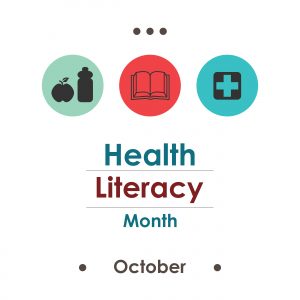2019 Health Literacy Month
Health Literacy Month

Photo Credit: Shutterstock ID 483372283
October is Health Literacy Month. According to the Institute for Healthcare Advancement, the purpose of health literacy month is “a time of observance when hospitals, health centers, literacy programs, libraries, social service agencies, businesses, professional associations, government agencies, consumer alliances, and many other groups can work collaboratively to draw more attention to, and develop local capacity for, addressing [health literacy issues].”
In our operationalizing UW Medicine’s Healthcare Equity Blueprint, the UW Medicine Healthcare Equity (UWM HCE) team is focused on supporting our workforce in better understanding how health literacy issues manifest during patient encounters. UWM HCE also strives to provide our colleagues with readily accessible tools to overcome patients’ health literacy barriers and improve patients’ experiences overall.
What is health literacy?
Health literacy is “the degree to which individuals have the capacity to obtain, process and understand basic health information needed to make appropriate health decisions” offers the United States Department of Health and Human Services (HHS). A measure of a person’s health literacy can be assessed by their ability to read and comprehend vital healthcare-related materials such as prescription bottles, appointment reminders, and digitized platforms such as MyChart.
The problem of health literacy and its negative impacts of healthcare outcomes cannot be understated. Only 12% of adults in the United States are highly proficient when it comes to health literacy. Lara Killian and Margo Coletti explains more in their American Medical Association Journal of Ethics article entitled The Role of Universal Health Literacy Precautions in Minimizing “Medspeak” and Promoting Shared Decision Making.
How is one’s overall literacy related to their health literacy?
The relationship between a person’s overall literacy and their health literacy is a multifaceted one. A patient may have high overall literacy levels and struggle to understand healthcare related information. Low health literacy involves more than an inability to clearly understand text. It can impact one’s ability to make the most ideal healthcare decisions in multiple situations. Lastly, a person can exhibit high verbal fluency – which makes detecting health literacy problems that more difficult for healthcare providers and others who facilitate healthcare services delivery.
In which ways can a health system like UW Medicine impact health literacy?

Photo Credit: UW Medicine Photo Library
The suggestions shown below were compiled from Kevin B. O’Reilly’s 2017 article in the Patient Support & Advocacy section of the Journal of the American Medical Association and the Health Literacy Precautions Toolkit published by the Agency for Healthcare Research and Quality (AHRQ).
- Cease use of Medspeak – medical, public health and other forms of jargon – which can impede shared decision making between patients and their healthcare provider. Is it necessary to use terms such as “agent” or “pathogen” when communicating to patients?
- Receive everyone irrespective of their health condition with a welcoming attitude.
- Make appropriate eye contact throughout the entire patient visit.
- Refrain from interrupting patients while they speak. Pay attention and respond to issues they raise/questions they pose.
- Be cognizant of the words patients use to describe their health condition(s) – use the same words in offering your input.
- Speak to patients in a non-condescending, non-patronizing, and clear tone. Speak at a moderate pace.
- Only express information that is absolutely necessary – limiting information to three to five points. Repeat them.
- Avoid vague and subjective terms that can be misconstrued.
- Make use of visual aids to demonstrate important concepts
- Demonstrate the instructions you are providing patients – such as how to apply, imbibe, or ingest medication correctly.
- Use appropriate body language – sit (at same level as patient), don’t stand.
- Look and listen – look at patient while speaking not at the chart, computer, phone, tablet, or other device.
- Ensure you are presenting yourself as having time and interest in conversing with the patient – opposed to appearing hurried or preoccupied.
Encourage patients to ask questions. Consider inviting them to converse by saying:
- What questions do you have?
- We discussed a lot of information. What would you like to review?
- [Diagnosis] may be new to you and I expect you have some questions. Which of the things we covered would you like to discuss?